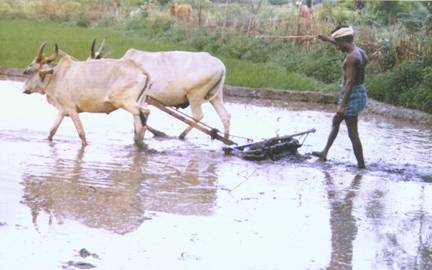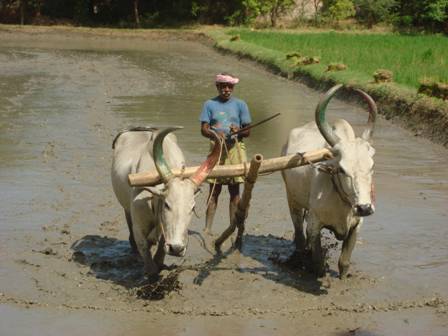RICE (Oryza sativa L.)
Transplanted Puddled Lowland Rice
Wet nursery
Forming Seedbeds
- Mark plots of 2.5m breadth with channels 30cm wide all around the seedbeds.
- Length of the seed bed may vary from 8 to 10m according to soil and slope of the land.
- Collect the puddled soil from the channel and spread on the seedbeds or drag a heavy stone along the channel to lower it, so that the seed bed is at a higher level.
- Level the surface of the seedbed, so that the water drains into the channel.
Dry nursery
- Dry ploughed field with fine tilth is required.
- Nursery area with sand and loamy soil status is more suitable for this type of nursery.
- Area 20cents.
- Plots of 1 to 1.5 m width of beds and channels may be formed. Length may be according to the slope and soil. Raised beds are more ideal if the soil is clayey in nature.
Main Field Management
Land preparation
- Plough the land during summer to economize the water requirement for initial preparation of land.
- Flood the field 1 or 2days before ploughing and allow water to soak in. Keep the surface of the field covered with water.
- Keep water to a depth of 2.5cm at the time of puddling.
- Special technologies for problem soils:
- For fluffy paddy soils: compact the soil by passing 400kg stone roller or oil-drum with stones inside, eight times at proper moisture level (moisture level at friable condition of soil which is approximately 13 to18%) once in three years, to prevent the sinking of draught animals and workers during puddling.

Keep water to a depth of 2.5cm at the time of puddling
SYSTEM OF RICE INTENSIFICATION (SRI)
Mat nursery preparation
- Preparation of nursery area: Prepare 100 m2 nurseries to plant 1 ha. Select a level area near the water source. Spread a plastic sheet or used polythene gunny bags on the shallow raised bed to prevent roots growing deep into soil.
Main field preparation
- Puddled lowland prepared as described in transplanted section
- Perfect leveling is a pre-requisite for the water management proposed hereunder
WET SEEDED PUDDLED LOWLAND RICE
Wet Seeded Rice
- On receipt of showers during the months of May - July repeated ploughing should be carried out so as to conserve the moisture, destroy the weeds and break the clods.
- After inundation puddling is to be done as per transplanting. More care should be taken to level the field to zero level.
- Stagnation of water in patches during germination and early establishment of the crop leads to uneven crop stand.
- Land leveling has say over efficient weed and water management practices.
- Provision of shallow trenches (15cm width) at an interval of 3m all along the field will facilitate the draining of excess water at the early growth stage.

Land levelling
DRY SEEDED RAINFED UN-PUDDLED LOWLAND RICE
- Dry plough to get fine tilth taking advantage of rains and soil moisture availability.
- Apply gypsum at 1 t/ha basally wherever soil crusting and soil hardening problem exist.
- Perfect land leveling for efficient weed and water management.
- Provide shallow trenches (15 cm width) at an interval of 3m all along the field to facilitate draining excess water at the early growth stage.
DRY SEEDED RAINFED UN-PUDDLED LOWLAND RICE WITH
SUPPLEMENTAL IRRIGATION
- Dry plough to get fine tilth taking advantage of rains and soil moisture availability.
- Apply gypsum at 1 t/ha basally wherever soil crusting and soil hardening problem exist.
- Perfect land leveling for efficient weed and water management.
- Provide shallow trenches (15 cm width) at an interval of 3m all along the field to facilitate draining excess water at the early growth stage.
- Pre-monsoon sowing is advocated for uniform germination.
DRY SEEDED IRRIGATED UN-PUDDLED LOWLAND RICE
- Dry plough to get fine tilth taking advantage of rains and soil moisture availability.
- Apply gypsum at 1 t/ha basally wherever soil crusting and soil hardening problem exist.
- Perfect land leveling for efficient weed and water management.
- Provide shallow trenches (15 cm width) at an interval of 3m all along the field to facilitate draining excess water at the early growth stage.
|


